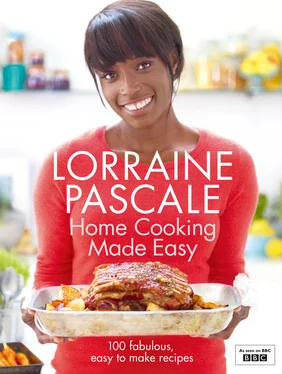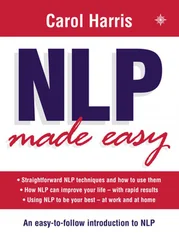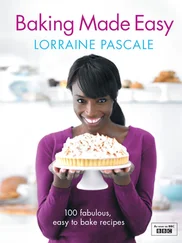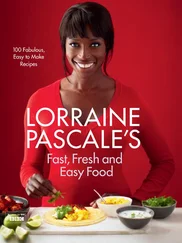Lorraine Pascale - Home Cooking Made Easy
Здесь есть возможность читать онлайн «Lorraine Pascale - Home Cooking Made Easy» — ознакомительный отрывок электронной книги совершенно бесплатно, а после прочтения отрывка купить полную версию. В некоторых случаях можно слушать аудио, скачать через торрент в формате fb2 и присутствует краткое содержание. Жанр: unrecognised, на английском языке. Описание произведения, (предисловие) а так же отзывы посетителей доступны на портале библиотеки ЛибКат.
- Название:Home Cooking Made Easy
- Автор:
- Жанр:
- Год:неизвестен
- ISBN:нет данных
- Рейтинг книги:3 / 5. Голосов: 1
-
Избранное:Добавить в избранное
- Отзывы:
-
Ваша оценка:
- 60
- 1
- 2
- 3
- 4
- 5
Home Cooking Made Easy: краткое содержание, описание и аннотация
Предлагаем к чтению аннотацию, описание, краткое содержание или предисловие (зависит от того, что написал сам автор книги «Home Cooking Made Easy»). Если вы не нашли необходимую информацию о книге — напишите в комментариях, мы постараемся отыскать её.
Home Cooking Made Easy — читать онлайн ознакомительный отрывок
Ниже представлен текст книги, разбитый по страницам. Система сохранения места последней прочитанной страницы, позволяет с удобством читать онлайн бесплатно книгу «Home Cooking Made Easy», без необходимости каждый раз заново искать на чём Вы остановились. Поставьте закладку, и сможете в любой момент перейти на страницу, на которой закончили чтение.
Интервал:
Закладка:
Makes 1 loaf (V)
275g strong white flour, plus extra for dusting and sprinkling
1 scant tsp sea salt, plus extra for the top
2 tsp fast-action dried yeast
150–185ml warm water
1 tbsp extra-virgin olive oil
Put the flour, 1 teaspoon of salt and the yeast in a large bowl. Add enough of the water to make a lovely soft dough and then the olive oil and mix with a wooden spoon until the mixture begins to come together a little. Put the spoon down and get your hands in, and squidge it together to form a ball. Knead the dough for 10 minutes if doing by hand, or for 5 minutes if using a machine.
Dust a large baking tray with flour, form the dough into a tight ball so that the top is really nice and taut, then roll it into a long and thin baguette shape (thinner than usual, as it will expand while it rises). Cover the tray with oiled clingfilm so it is airtight but not too taut, giving the dough room to expand. Leave it in a warm place for about 1 hour, or until doubled in size. I usually leave mine on a chair near the oven.
Preheat the oven to 200°C (400°F), Gas Mark 6. Once the bread has almost doubled in size, remove the clingfilm and sprinkle over some flour. Put the bread with the shortest edge facing you (or lengthways) and, starting at the end furthest away from you, hold a pair of scissors so they are parallel to the bread, then tilt them so they are at a 45-degree angle. Make a large cut 10cm away from the top of the dough, almost as if you were going to snip that bit off (but it will be attached still), then take that piece and move it to the left. Make another snip about 10cm down from the bottom of the last one and move that piece to the right. Keep on doing this until you reach the end of the bread.
Sprinkle the top with flour and sea salt. Spray some water into the oven to create a steamy atmosphere. I usually spray 8–10 squirts with a spray gun, then place the dough in the oven. Bake for about 25 minutes, or until the bread is cooked. It should smell cooked, be golden brown and sound hollow when you tap it on the bottom.
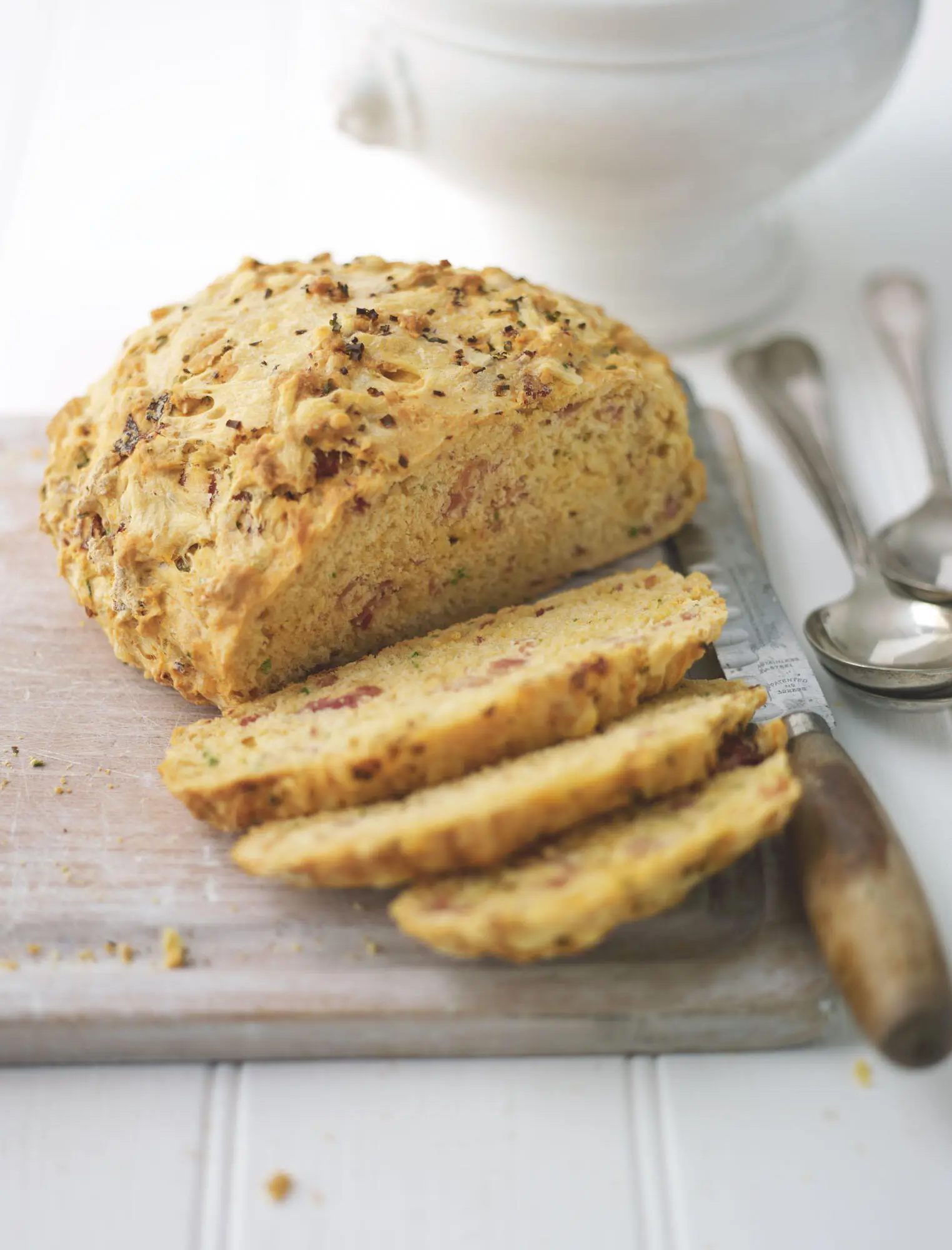
Twenty-first century ham, cheese & chive bread
On weekends I love to spend hours in the kitchen preparing fresh breads, hearty meat dishes and lots of puddings. I especially love the taste of freshly baked bread! I find that during the week, however, sometimes there just aren’t enough hours in the day for baking, so I dreamed up this very tasty little number, which is made from start to finish in under an hour – the perfect 21st-century bread.
Makes 1 loaf
425g self-raising flour
1 tsp baking powder
½ tsp salt
150g mature Cheddar cheese, grated, plus an extra 10g grated cheese, for sprinkling
½ bunch of fresh chives, finely chopped
Few twists of black pepper
1 tsp paprika (optional)
1 tsp mustard powder (optional)
6 slices of honey roast ham, ripped up into little bits
200–225ml water
Preheat the oven to 200°C (400°F), Gas Mark 6. Put all of the ingredients in a bowl except the water and the 10g of grated cheese and mix together well. Add enough water to make a soft but not sticky dough. I usually add 200ml, stir it briefly and then get my hands in and squidge it together, adding more water if necessary. Remove the dough from the bowl and shape it into a ball, flatten the ball slightly, so it cooks more quickly, then slash the loaf three times vertically with a sharp knife. Sprinkle over the remaining grated cheese.
Spray some water into the oven to create a steamy atmosphere. I usually spray 8–10 squirts with a spray gun, then place the dough on a baking tray and bake for 35–45 minutes, or until the bread is golden brown and smells cooked.
Once cooked, remove from the oven and leave to cool a little bit (although I find this quite hard to do!). I love this bread served with lots of butter and a steaming hot bowl of soup.
Old-fashioned English muffins
These beautiful little specimens are truly hard to beat when it comes to the ultimate comfort food.
Makes 8–10 muffins (V)
575g strong white bread flour
1 tsp salt
1 x 7g sachet of fast-action dried yeast
2 tbsp soft light brown sugar
150ml warm water
175–225ml milk, at room temperature
Oil, for oiling
Equipment
Round pastry cutter; my cutter measured 8.5cm
Put the flour, salt, yeast and sugar in a bowl, then make a well in the centre and pour in the water and milk. Use a wooden spoon to stir it all together, then put the spoon down and use your hands to bring the mixture together into a ball. Knead for 10 minutes by hand or for 5 minutes if using a food processor fitted with a dough hook.
Once it has been kneaded, place the dough in a bowl, cover with oiled clingfilm and leave in a warm place for 1 hour, or until doubled in size.
Preheat the oven to 200°C (400°F), Gas Mark 6. Once the dough is ready, remove it from the bowl and roll it out into a rough circle, about 1.5–2cm thick. Cut out 8–10 circles with the round pastry cutter. Usually when I do these I have to scrunch the dough up and re-roll it so I get the right amount of circles.
Put a flat baking tray or very large frying pan over a low heat. Once the tray or pan is hot, place a few of the circles on the tray or pan and cook slowly for about 4 minutes on each side. It is possible to cook the muffins completely on the hob, but if they have begun to go too dark and are still looking a bit doughy on the sides they can be finished off in the oven for about 5–8 minutes.
Once they are cooked, remove them from the oven/hob and slice in half. I do like to pop these in the toaster or back on the baking tray, cut side down, to crisp up the inside. Then they can be slathered with hot butter and raspberry jam. Totally delicious!
Hamburger baps
I am all for breads with a crunchy crust and am a great advocate of those, but there is also a certain beauty in a soft doughy roll that squidges when lightly pressed. So I embarked on a journey for a soft(ish) roll and found the best way to get one was to use plain flour. If these are cooked for too long, a firm top will result; but if cooked for just the right amount of time, the top will stay soft and squidgy. These baps are great with the salmon and sweet potato fish cakes, or even the lamb and mint burgers. When time permits, I double the ingredients and then pop half the baps into the freezer for another day.
Makes 5 baps (V)
525g plain flour
2 tsp salt
2 tbsp soft light brown sugar
1 x 7g sachet of fast-action dried yeast
150ml warm milk, plus extra for brushing
125–150ml warm water
Sesame seeds
Put the flour, salt, sugar and yeast in bowl. Make a well in the centre and pour in the milk and enough water to make a soft dough. The softer the dough, the better because it will mean the buns will have a really nice rise. Knead the dough for a good 10 minutes if doing by hand and 5 minutes if using a mixer fitted with a dough attachment. To test when the dough is ready, form the dough into a ball so that it has a nice tight top, then using a floured finger, prod it into the dough – if it springs back all the way, then it is ready. Divide the dough into 5 equal portions. Mine weighed 170g each, but this will depend on how much water you have used. Take one portion and shape it into a ball. I like to pull the sides down of the ball down and under so that the top of the bread becomes tight. This makes the bread look really nice when it is cooked.
Now place a dough ball on a baking tray and squash it down a little to flatten it slightly. Repeat with the rest of the dough, placing the dough balls on the tray fairly spaced apart because they will spread during baking. Once all the dough balls are formed, cover them with oiled clingfilm so that it is loose but airtight. I normally have to use several pieces of clingfilm to cover them sufficiently. Leave to rise in a warm place for about 1 hour, or until the dough balls have almost doubled in size.
Читать дальшеИнтервал:
Закладка:
Похожие книги на «Home Cooking Made Easy»
Представляем Вашему вниманию похожие книги на «Home Cooking Made Easy» списком для выбора. Мы отобрали схожую по названию и смыслу литературу в надежде предоставить читателям больше вариантов отыскать новые, интересные, ещё непрочитанные произведения.
Обсуждение, отзывы о книге «Home Cooking Made Easy» и просто собственные мнения читателей. Оставьте ваши комментарии, напишите, что Вы думаете о произведении, его смысле или главных героях. Укажите что конкретно понравилось, а что нет, и почему Вы так считаете.
